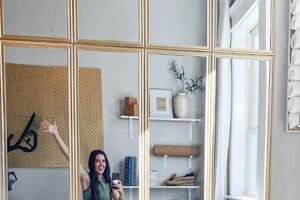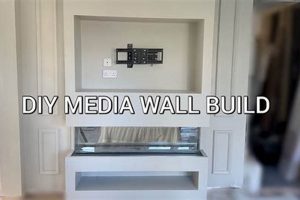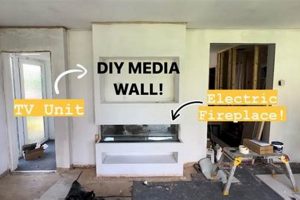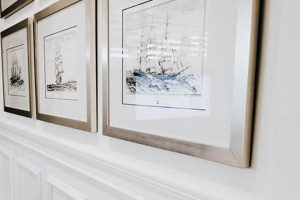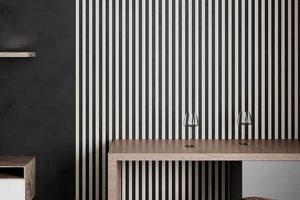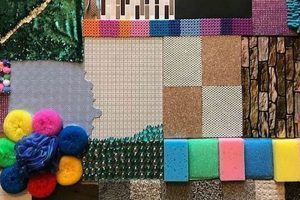Pre-fabricated coverings designed for shower interiors and intended for installation by the homeowner or non-professional constitute a significant segment of the home improvement market. These modular units offer an alternative to traditional tile or poured shower surfaces, providing a potentially faster and less complex installation process. For example, a homeowner might choose to install interlocking acrylic sheets in a standard-sized shower enclosure rather than hiring a tile setter.
The appeal of self-installation stems from several factors including cost reduction, time savings, and perceived ease of implementation. Historically, shower construction necessitated specialized skills, leading to higher labor costs. By offering simplified installation methods, these systems democratize the remodeling process, granting greater control and autonomy to homeowners seeking to upgrade their bathrooms. Furthermore, these solutions often boast enhanced water resistance and easier maintenance compared to conventional tiling.
The following sections will delve into the various types of these coverings available, examining material properties, installation techniques, cost considerations, and potential challenges associated with their use. This exploration aims to provide a comprehensive understanding of this evolving home improvement option.
Installation Guidance
Successful implementation of pre-fabricated shower coverings requires careful planning and adherence to recommended procedures. The following guidelines offer insights for a durable and aesthetically pleasing final product.
Tip 1: Precise Measurement is Paramount: Accurate assessment of the shower enclosure’s dimensions is crucial. Variations from stated sizes can necessitate cutting and fitting, potentially compromising the integrity of the material and the water-tight seal. Double-check all measurements before acquiring materials.
Tip 2: Substrate Preparation is Essential: Ensure the existing shower wall is clean, level, and structurally sound. Repair any damage, such as cracks or mold, prior to installation. A smooth, even surface will facilitate proper adhesion and prevent future issues.
Tip 3: Select Appropriate Adhesive: Consult the manufacturer’s recommendations regarding adhesive type. Using an incompatible adhesive can lead to bonding failure, resulting in leaks and eventual material degradation. Verify the adhesive’s suitability for both the covering material and the substrate.
Tip 4: Maintain Consistent Spacing: Utilize spacers to ensure uniform gaps between adjacent panels. Consistent spacing contributes to a professional appearance and allows for proper sealant application. Adherence to specified gap widths is important for long-term performance.
Tip 5: Apply Sealant Meticulously: A high-quality sealant is vital for preventing water intrusion. Apply sealant along all seams and joints, ensuring complete coverage. Select a sealant specifically formulated for wet environments and resistant to mold growth.
Tip 6: Allow Adequate Curing Time: Adhesives and sealants require sufficient time to cure properly. Adhering to the manufacturer’s recommended curing period is crucial for achieving optimal bond strength and water resistance. Avoid using the shower until the curing process is complete.
Tip 7: Inspect for Leaks Post-Installation: After the curing period, thoroughly inspect the shower for any signs of leaks. Address any issues promptly to prevent water damage and potential mold growth. A proactive approach to leak detection is critical for maintaining the integrity of the installation.
These guidelines, when implemented correctly, contribute significantly to the longevity and performance of the shower enclosure. Proper planning and execution are fundamental to achieving a successful outcome.
The subsequent section will address troubleshooting common issues encountered during installation, providing practical solutions to ensure a professional-grade result.
1. Material Selection
The selection of materials for self-installed shower coverings is a primary determinant of both the aesthetic appeal and the functional performance of the finished enclosure. The chosen material dictates factors such as water resistance, durability, ease of maintenance, and overall cost. Therefore, a thorough understanding of available options and their respective properties is crucial for informed decision-making.
- Acrylic Sheets
Acrylic sheets, a common choice, offer a smooth, non-porous surface that is relatively easy to clean. They are typically less expensive than some alternatives but may be more susceptible to scratching and discoloration over time. The ease of cutting and installation is a primary advantage, but careful handling is required to avoid damage during the process. For example, a homeowner might opt for acrylic for a cost-effective remodel, accepting a potentially shorter lifespan compared to higher-end materials.
- Composite Panels
Composite panels, often consisting of a core material sandwiched between layers of more durable material, provide enhanced structural integrity and resistance to impact. These panels may offer a wider range of textures and patterns, mimicking the look of natural stone or tile. However, composite panels can be more challenging to cut and install, potentially requiring specialized tools and techniques. A typical example involves a panel with a waterproof PVC core and an outer layer resembling marble, balancing aesthetics with practical considerations.
- Fiberglass Reinforced Plastic (FRP)
FRP is known for its high durability and resistance to moisture, making it a suitable option for shower enclosures. FRP panels are lightweight and relatively easy to install, but their aesthetic options may be limited compared to other materials. They are commonly used in commercial settings due to their ease of cleaning and resistance to mold and mildew. A practical application might be in a frequently used shower in a rental property, where durability and ease of maintenance are prioritized over visual appeal.
- Simulated Stone
Simulated stone coverings aim to replicate the look of natural stone at a lower cost and with easier installation. These materials can vary widely in quality, with some offering a convincing aesthetic while others may appear artificial. Factors such as the realism of the texture and the durability of the surface finish should be carefully considered. For instance, a homeowner aiming for a luxurious bathroom aesthetic on a budget might choose a simulated stone panel over natural stone, provided the material offers sufficient durability and visual appeal.
The selection of appropriate coverings requires a careful evaluation of trade-offs between cost, durability, aesthetics, and ease of installation. By considering these factors, homeowners can select a material that meets their specific needs and budget while ensuring a long-lasting and visually appealing shower enclosure. The proper selection of components also minimizes potential future repairs and maintenance efforts.
2. Installation Techniques
Proficient application methods are paramount to the successful implementation of prefabricated shower coverings. The adherence to specific procedures, determined by the material type and manufacturer specifications, directly impacts the longevity, watertight integrity, and aesthetic quality of the final installation.
- Surface Preparation and Leveling
Adequate preparation of the substrate is essential for proper adhesion and preventing future failures. This encompasses cleaning, patching imperfections, and ensuring a level surface. Deviations from a flat plane can lead to uneven bonding, stress points, and eventual cracking or detachment of the covering. For example, failing to remove old adhesive residue can compromise the new bond, leading to water infiltration.
- Cutting and Fitting
Precise cutting and fitting of the panel components are crucial for achieving a seamless and watertight installation. Accurate measurements and the use of appropriate cutting tools minimize gaps and ensure proper alignment. Improper cuts can result in exposed edges, requiring extensive caulking and potentially compromising the waterproof barrier. As an illustration, inaccurate cutting around plumbing fixtures can create pathways for water to penetrate behind the panels.
- Adhesive Application
The selection and application of the correct adhesive are critical for ensuring a durable and lasting bond between the covering and the substrate. Compatibility between the adhesive and the panel material is essential. The adhesive must be applied evenly and in accordance with the manufacturer’s recommendations to prevent voids and ensure adequate bonding strength. As an example, using a general-purpose construction adhesive instead of a specialized sealant designed for wet environments can lead to premature failure.
- Sealing and Caulking
Proper sealing and caulking are necessary to prevent water intrusion at seams, joints, and edges. The type of sealant used must be compatible with the panel material and resistant to mold and mildew growth. Applying sealant in a continuous and uniform bead is crucial to create a watertight barrier. For example, neglecting to caulk the joint between the shower pan and the covering can result in water damage to the subfloor.
The integration of these installation techniques, executed with precision and attention to detail, directly influences the overall success of the project. Adherence to best practices minimizes the risk of leaks, ensures structural integrity, and contributes to the long-term performance of the prefabricated shower enclosure. Overlooking any of these steps can compromise the entire installation, leading to costly repairs and potential water damage.
3. Waterproof Sealing
Waterproof sealing constitutes an indispensable element in the successful deployment of do-it-yourself shower wall panel systems. The inherent purpose of a shower enclosure is to contain water, thereby preventing structural damage and mitigating the growth of mold and mildew. The effectiveness of the entire system hinges on the integrity of the waterproof barrier established during installation. Inadequate sealing invariably leads to water penetration, compromising the substrate and potentially causing significant and costly remediation efforts. For example, poorly sealed seams between panels allow water to seep behind the installation, leading to wood rot in the wall studs or the development of unsanitary mold colonies.
The specific methodologies employed for achieving effective waterproof sealing vary depending on the type of panels used. Acrylic panels may necessitate specialized sealants designed for use with plastics, while composite materials could require adhesives with specific moisture-resistant properties. Irrespective of the panel type, the consistent and thorough application of sealant along all seams, joints, and penetrations (such as plumbing fixtures) is crucial. The absence of a continuous, unbroken seal creates vulnerabilities that compromise the entire system. As a practical illustration, the failure to properly caulk around the showerhead or faucet escutcheons provides a direct pathway for water to enter the wall cavity.
In conclusion, effective waterproof sealing is not merely an ancillary consideration but rather a foundational requirement for the longevity and functional efficacy of self-installed shower coverings. Ignoring or underestimating the importance of this aspect inevitably results in compromised performance and the potential for extensive water damage. Therefore, meticulous attention to detail and adherence to best practices in sealing techniques are paramount to achieving a successful and enduring installation. These factors should be carefully considered before embarking on a shower renovation or build.
4. Substrate Preparation
Substrate preparation constitutes a foundational stage in the successful implementation of self-installed shower coverings. The condition of the underlying wall surface directly influences the adhesion, stability, and longevity of the installed panels. Inadequate substrate preparation leads to compromised bonding, uneven surfaces, and potential water intrusion, ultimately diminishing the overall effectiveness of the shower enclosure. As a causal example, installing panels over a pre-existing layer of loose or peeling paint significantly reduces the adhesive’s ability to properly bond, increasing the likelihood of panel detachment and water leaks. The substrate must be structurally sound, clean, dry, and level to ensure the panels are adequately supported and sealed.
The importance of proper substrate preparation extends beyond merely ensuring adhesion. A level and even substrate guarantees that the panels are installed without undue stress or strain. Uneven surfaces can create stress points, leading to cracking or warping of the panels over time. Furthermore, thorough cleaning of the substrate removes contaminants such as mold, mildew, or soap scum, which can compromise the adhesive bond and create an environment conducive to future microbial growth. For instance, failing to remove existing mold spores before panel installation can result in the mold continuing to grow behind the panels, causing health issues and necessitating costly remediation. Practical significance is evident in the reduced risk of callbacks, extended panel lifespan, and enhanced customer satisfaction when substrate preparation is prioritized.
In summary, substrate preparation is not simply a preliminary step but an integral component that is fundamental to the structural integrity and performance of self-installed shower panels. Overlooking or underestimating this process introduces significant risks, potentially resulting in premature failure, water damage, and costly repairs. Therefore, a meticulous and thorough approach to substrate preparation is essential to realize the full benefits of these systems and ensure a long-lasting, waterproof shower enclosure. This crucial link between substrate and shower finishing requires a thorough understanding and careful approach, to ensure a long lasting high quality result.
5. Cost Effectiveness
The economic feasibility of self-installing shower wall panels represents a primary driver for many homeowners considering this renovation approach. The overall cost-effectiveness is determined by a confluence of factors that extend beyond the initial purchase price of the materials.
- Reduced Labor Expenses
The elimination of professional labor fees constitutes a significant cost saving. Traditional shower renovations often necessitate hiring skilled tile setters, plumbers, and potentially demolition crews, each contributing to the overall project expense. By undertaking the installation, the homeowner avoids these costs, limiting expenses primarily to materials and tools. For example, a standard tile shower installation might incur labor costs exceeding the material expenses, whereas a DIY panel installation substantially reduces this overhead.
- Material Cost Considerations
The price of the panels themselves can vary substantially based on the material, design, and vendor. While some panels may appear initially inexpensive, it is crucial to consider factors such as durability, water resistance, and aesthetic appeal. Investing in higher-quality panels can result in long-term savings by reducing the need for frequent repairs or replacements. For example, choosing a cheaper acrylic panel over a more durable composite option might lead to earlier cracking or fading, negating the initial cost savings.
- Mitigation of Long-Term Maintenance
Certain panels are inherently easier to clean and maintain than traditional tile showers, reducing the ongoing costs associated with cleaning supplies and potential mold remediation. The non-porous surfaces of many panel materials inhibit the growth of mold and mildew, minimizing the need for specialized cleaning agents or professional services. For instance, a homeowner might save annually on cleaning products and time by opting for panels that resist staining and microbial growth.
- Potential for Increased Home Value
A well-executed shower renovation, even with self-installed panels, can increase the overall value of a home. A modern and aesthetically pleasing shower enclosure can be a significant selling point, attracting potential buyers and justifying a higher asking price. While the impact on home value varies based on location and market conditions, a thoughtfully designed and properly installed shower renovation generally represents a worthwhile investment. In a competitive real estate market, updated bathrooms often distinguish a property and accelerate the sales process.
The overall cost-effectiveness of DIY shower wall panels is not solely a function of initial price but also a consideration of long-term maintenance requirements, potential increases in home value, and the avoidance of professional labor expenses. A comprehensive assessment of these factors is crucial in determining whether this renovation approach aligns with individual budgetary constraints and long-term financial goals. The DIY aspect can save money, but careful selection of materials and proper installation are vital to ensuring lasting value and avoiding future expenses.
6. Long-Term Durability
The long-term durability of self-installed shower coverings directly correlates with their sustained functionality and aesthetic appeal, influencing their overall value and minimizing the need for premature replacement or repair. Material selection, installation quality, and environmental conditions all contribute to the lifespan of these systems.
- Material Resistance to Moisture and Degradation
The inherent resistance of the covering material to water penetration, chemical exposure, and UV degradation is a primary determinant of longevity. Materials prone to absorbing moisture or susceptible to damage from cleaning agents will exhibit reduced lifespans. For example, acrylic panels, while cost-effective, may yellow or crack over time if exposed to harsh chemicals or prolonged moisture, while composite panels with a protective top layer offer superior resistance to these factors.
- Joint and Seam Integrity
The integrity of the sealed joints and seams between panels is crucial for preventing water intrusion and maintaining structural stability. Improperly sealed joints can allow water to seep behind the panels, leading to mold growth, substrate damage, and eventual panel delamination. The use of high-quality, mold-resistant sealants and proper application techniques are essential for preserving the integrity of these critical areas. For example, a silicone-based sealant specifically formulated for wet environments offers superior protection compared to a general-purpose caulk.
- Structural Support and Substrate Stability
The underlying structural support and stability of the substrate directly influence the longevity of the installed panels. A weak or unstable substrate can cause panels to shift, crack, or detach over time. Ensuring that the substrate is structurally sound, level, and properly prepared is essential for providing adequate support. For example, installing panels over a damaged or deteriorating drywall surface will compromise their stability and shorten their lifespan.
- Resistance to Impact and Abrasion
The ability of the covering material to withstand impact and abrasion from daily use is a significant factor in its long-term appearance and functionality. Panels that are easily scratched, dented, or chipped will exhibit a diminished aesthetic appeal over time, potentially requiring costly repairs or replacements. Selecting materials with a durable surface finish and implementing protective measures, such as avoiding abrasive cleaners, can help to preserve their appearance. For example, textured composite panels may be more resistant to scratches and scuffs compared to smooth acrylic surfaces.
The multifaceted nature of long-term durability necessitates a holistic approach encompassing material selection, installation proficiency, and ongoing maintenance. Careful consideration of these factors ensures that self-installed shower coverings maintain their functional and aesthetic integrity for an extended period, providing lasting value and minimizing the need for costly interventions.
7. Maintenance Requirements
Sustained performance and aesthetic appeal of self-installed shower wall panels are inextricably linked to diligent and appropriate maintenance practices. The longevity and hygiene of these enclosures are directly influenced by the chosen cleaning methods and frequency of application.
- Regular Cleaning Protocols
Consistent cleaning practices are essential to prevent the accumulation of soap scum, mineral deposits, and potential mold or mildew growth. Neglecting regular cleaning can lead to stubborn stains and compromised hygiene, diminishing the overall lifespan of the panels. For instance, weekly cleaning with a non-abrasive cleaner can prevent the buildup of soap residue, whereas infrequent cleaning may necessitate the use of harsher chemicals, potentially damaging the panel surface.
- Appropriate Cleaning Agents
Selection of suitable cleaning agents is critical to avoid damaging the panel material. Abrasive cleaners, scouring pads, and harsh chemicals can scratch or dull the surface, compromising its aesthetic appeal and potentially increasing its susceptibility to water damage. Using pH-neutral cleaners specifically formulated for the panel material ensures effective cleaning without causing harm. For example, a cleaner designed for acrylic panels will typically differ from one suitable for composite materials.
- Seam and Joint Inspection
Periodic inspection of seams and joints is crucial for identifying potential breaches in the waterproof seal. Cracks, gaps, or discoloration in the sealant indicate a need for repair or replacement. Promptly addressing these issues prevents water intrusion and subsequent damage to the substrate. For example, inspecting the caulk around the showerhead and along the panel edges can reveal early signs of deterioration, allowing for timely intervention.
- Preventative Measures
Proactive measures, such as ensuring adequate ventilation and promptly addressing leaks, contribute significantly to the longevity of the panels. Proper ventilation reduces moisture buildup, inhibiting mold and mildew growth. Addressing leaks promptly prevents water damage to the substrate and minimizes the risk of panel delamination. For instance, installing or using the exhaust fan during and after showers reduces humidity levels and minimizes moisture accumulation.
Effective maintenance of self-installed shower coverings demands a proactive approach that encompasses regular cleaning, appropriate cleaning agent selection, consistent seam and joint inspection, and the implementation of preventative measures. Adherence to these practices guarantees sustained hygiene, aesthetic appeal, and an extended lifespan for the shower enclosure. Improper or neglected maintenance undermines the benefits of self-installation and precipitates premature degradation, negating initial cost savings.
Frequently Asked Questions Regarding DIY Shower Wall Panels
The following questions and answers address common inquiries and concerns surrounding the selection, installation, and maintenance of these systems.
Question 1: What types of substrates are suitable for panel installation?
Acceptable substrates include cement backer board, moisture-resistant drywall (often referred to as “green board” or “blue board”), and existing tile surfaces that are structurally sound and properly prepared. Surfaces must be clean, level, and free of any loose materials or contaminants that could compromise adhesion.
Question 2: Can these panels be installed directly over existing tile?
Installation over existing tile is feasible provided the tile surface is structurally sound, level, and properly cleaned. Loose or damaged tiles must be repaired or removed prior to panel installation. A bonding primer may be necessary to ensure proper adhesion.
Question 3: What tools are required for a typical panel installation?
Essential tools typically include a measuring tape, level, straight edge, utility knife or panel saw (depending on the material), adhesive applicator (caulk gun or trowel), sealant, spacers, and safety glasses. Some installations may require additional tools such as a drill or jigsaw for cutting around plumbing fixtures.
Question 4: How is waterproofing achieved with these systems?
Waterproofing is achieved through a combination of properly sealed seams, joints, and penetrations (e.g., plumbing fixtures). High-quality, mold-resistant sealants designed for wet environments are essential. The manufacturer’s instructions regarding sealant application must be followed precisely.
Question 5: What is the typical lifespan of these panels?
The lifespan varies depending on the material, installation quality, and maintenance practices. Higher-quality materials and diligent maintenance can extend the lifespan to 10 years or more. However, factors such as water damage, improper cleaning, or physical impact can significantly shorten the lifespan.
Question 6: How are these panels cleaned and maintained?
Regular cleaning with a non-abrasive cleaner is recommended. Harsh chemicals and scouring pads should be avoided as they can damage the panel surface. Inspecting and resealing seams and joints as needed is crucial for maintaining a waterproof barrier.
Proper selection, installation, and maintenance practices are critical for ensuring the longevity and performance of do-it-yourself shower wall panel systems. Adherence to manufacturer guidelines and best practices minimizes the risk of water damage and ensures a lasting, aesthetically pleasing result.
The subsequent section will present a comparative analysis of various panel materials, highlighting their advantages, disadvantages, and suitability for different applications.
Conclusion
The preceding analysis has explored the multifaceted nature of DIY shower wall panels, examining material properties, installation techniques, cost implications, and long-term performance considerations. Selection and implementation necessitate a comprehensive understanding of these factors to ensure a durable and aesthetically pleasing outcome. Careful consideration of substrate preparation, waterproof sealing, and appropriate maintenance protocols remains paramount.
Ultimately, the successful adoption of DIY shower wall panels hinges on informed decision-making and diligent execution. Prioritizing quality materials, adhering to established best practices, and consistently monitoring the installation’s integrity will yield a shower enclosure that balances cost-effectiveness with sustained performance. The continued innovation in material science and installation methodologies holds promise for enhancing the accessibility and longevity of these systems in the future.


